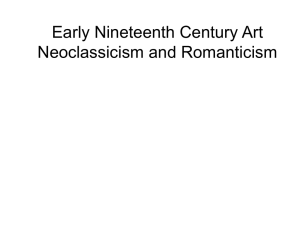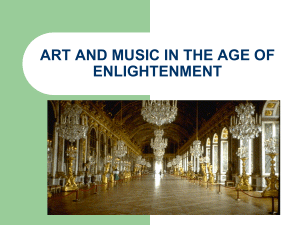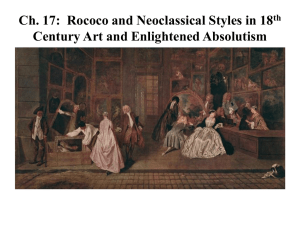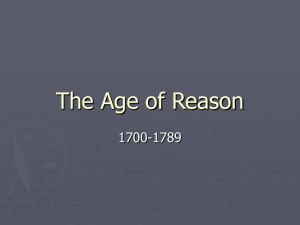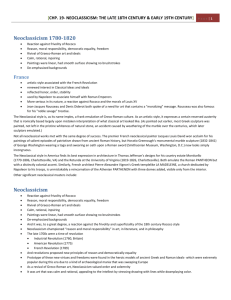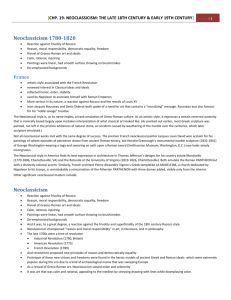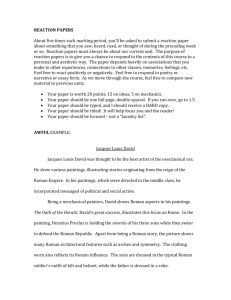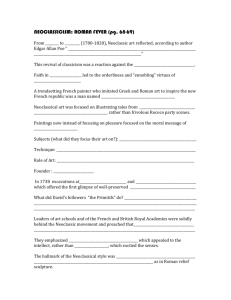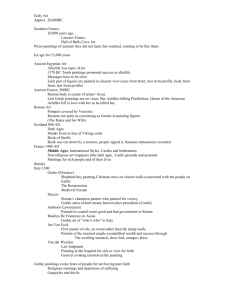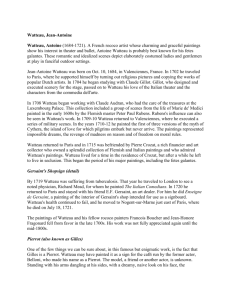modern.doc - LaCourART
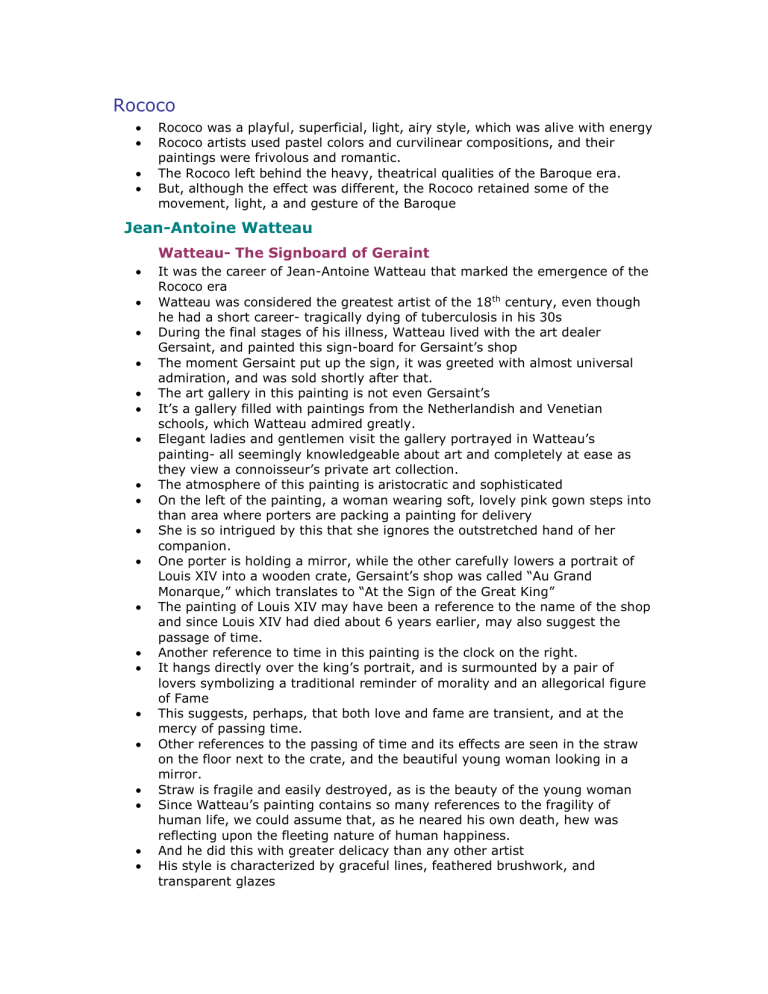
Rococo
Rococo was a playful, superficial, light, airy style, which was alive with energy
Rococo artists used pastel colors and curvilinear compositions, and their
paintings were frivolous and romantic.
The Rococo left behind the heavy, theatrical qualities of the Baroque era.
But, although the effect was different, the Rococo retained some of the movement, light, a and gesture of the Baroque
Jean-Antoine Watteau
Watteau- The Signboard of Geraint
It was the career of Jean-Antoine Watteau that marked the emergence of the
Rococo era
Watteau was considered the greatest artist of the 18 th century, even though he had a short career- tragically dying of tuberculosis in his 30s
During the final stages of his illness, Watteau lived with the art dealer
Gersaint, and painted this sign-board for Gersaint’s shop
The moment Gersaint put up the sign, it was greeted with almost universal admiration, and was sold shortly after that.
The art gallery in this painting is not even Gersaint’s
It’s a gallery filled with paintings from the Netherlandish and Venetian schools, which Watteau admired greatly.
Elegant ladies and gentlemen visit the gallery portrayed in Watteau’s painting- all seemingly knowledgeable about art and completely at ease as they view a connoisseur’s private art collection.
The atmosphere of this painting is aristocratic and sophisticated
On the left of the painting, a woman wearing soft, lovely pink gown steps into than area where porters are packing a painting for delivery
She is so intrigued by this that she ignores the outstretched hand of her
companion.
One porter is holding a mirror, while the other carefully lowers a portrait of
Louis XIV into a wooden crate, Gersaint’s shop was called “Au Grand
Monarque,” which translates to “At the Sign of the Great King”
The painting of Louis XIV may have been a reference to the name of the shop and since Louis XIV had died about 6 years earlier, may also suggest the passage of time.
Another reference to time in this painting is the clock on the right.
It hangs directly over the king’s portrait, and is surmounted by a pair of lovers symbolizing a traditional reminder of morality and an allegorical figure of Fame
This suggests, perhaps, that both love and fame are transient, and at the
mercy of passing time.
Other references to the passing of time and its effects are seen in the straw on the floor next to the crate, and the beautiful young woman looking in a mirror.
Straw is fragile and easily destroyed, as is the beauty of the young woman
Since Watteau’s painting contains so many references to the fragility of human life, we could assume that, as he neared his own death, hew was reflecting upon the fleeting nature of human happiness.
And he did this with greater delicacy than any other artist
His style is characterized by graceful lines, feathered brushwork, and transparent glazes
Jean Baptiste Simeon Chardin
Chardin’s- The House of Cards c. 1735
Although he painted at the height of the French Rococo period, Jean Baptiste
Simeon Chardin independently worked in an understated, naturalistic vein- in contrast to the romantic style of Watteau.
Chardin painted still lifes and genre subjects, scenes of everyday, middleclass life in France during the 18 th century
Chardin’s paintings have a solidity, an intimacy, and an unpretentious dignity
The young man in this painting is totally absorbed in building his house of cards- enjoying himself as he wastes time
This may have been Chardin’s way of expressing the fleeting, fragile nature of life.
Although he experienced some critical disfavor late in his career, Chardin’s quietly glowing solidly-constructed paintings have had considerable influence
on a great deal of the painting of the 20th century
By the middle of the 18 th century, the frivolous Rococo era begin to give way to the Age of Reason. The Age of Reason was a time when political and economic stresses cause people to have a more serious attitude, and this change in attitude led to the study and reinterpretation of Classical Greek and roman art- the same art that had inspired the artist of the Renaissance
This time around, however, the interpretation of Greco-Roman art and ideals inspired the style known as Neoclassicism or “new classicism”
So today, we’ll begin discussing some of many isms in art—romanticism, neoclassicism, and realism
The isms represent the styles that directly influenced modern and contemporary art
Neoclassicism
Blossomed between 1780-1820
And it was, to a great degree, a reaction against the frivolity and superficiality of the 18 th century Rococo style
Neoclassicism championed “reason and moral responsibility” in art, in literature, and in philosophy
The late 1700s were a time of revolution o Industrial Revolution (1760, Britain) o American Revolution (1775) o French Revolution (1789)
And revolutions proposed new principles of reason and democratically equality
Prototype of these new virtues and freedoms were found in the heroic models of ancient Greek and Roman ideals- which were extremely popular during this era due to a kind of archaeological mania that was sweeping Europe
As a revival of Greco-Roman art, Neoclassicism valued order and solemnity
It was art that was calm and rational, appealing to the intellect by stressing
drawing with lines while downplaying color.
Neoclassical artists left no trace of brushstrokes in their work, smoothing the surface o f their paintings until they appeared polished, quite different from the feathery brushwork of the Rococo artists.
Neoclassical compositions were simple, and often used Greek and Roman history and mythology as their subject matter
Neoclassical artist insisted that their art be inspirational and morally uplifting
The founder of the neoclassical style was Jacques Louis David, who had been deeply affected by Classical art when he visited Rome, and decided that he wanted to work in a pure Greek style
The Neoclassical style was a clear reaction against frivolous, ornate, melodramatic Rococo style
In fact, neoclassical artists felt such strong reaction against Rococo art, that they actually threw bread pellets at Watteau's Rococo paintings.
And the Neoclassicists were so enthralled with everything Greco-Roman that some of them actually dressed in sort tunics and bathed nude in the Sine, fantasizing that they were Greek athletes
SO, neoclassical artists and scholars revives the perfect beauty, severity and exalted simplicity of ancient Greece and Rome to symbolize the revolutionary
national aspirations and the struggle for equality and civil rights.
David’s Neoclassical paintings emphasized line, and minimized the importance of color
Davis de-emphasized backgrounds, so there were no deep, dimensional landscapes to detract them from the high, ethical issues implied in his paintings.
These characteristics are evident in David’ Death of Marat 1793
David was a revolutionary, having voted to guillotine Louis XVI
He attempted in his paintings, in his own words, to “plant the seeds of glory and devotion of the fatherland.”
This painting is of David’s close friend after he’s been stabbed to death by a counterrevolutionary, Charlotte Corday
Because he had contracted psoriasis while hiding from the policies in the sewers of Paris, Marat had been soaking in a medicated bath, using a packing box as a desk, when Corday attacked him
As Marat’s close friend, David was notified of Marat’s assassination immediately, and ran to record the scene
Out of respect for Marat, David left the background of the painting blank, emphasizing the box, the knife, and the blood-stained towel as objects to be worshipped, and elevating Marat to the level of a saint.
In fact, Marat is posed in the same way as Christ in Michelangelo’s Pieta and
Caravaggio’s Deposition of Christ
David was jailed for his revolutionary activities, but then decided to adapt to the times and became head of Napoleon’s art program
After that, he gave up his revolutionary ways and began to glorify Napoleon in pomp and pageantry, suing bright colors.
Following David, the first portion of the 19 th century became a nasty competition between two French painters, Jean Auguste Dominique Ingres, who championed Neoclassicism, and Eugene Delacroix, who was an ardent defender of the Romantic style in art
Ingres had been a student of David, and painted in a similar, flat, linear style, following his master’s advice to never let brushstrokes show.
Ingres La Grande Odalisque 1814
Term odalisque refers to a harem girl
Although Ingres was a controlled, academic Neoclassicist, his odalisque is sensual and distorted, far from the Greek or Roman ideal-actually, more like a
Mannerist work
Ingres painted her with an elongated back and limbs to create sensual elegance.
Critics attacked his odalisque, saying that she had one vertebrae too many, that her head was too small, and that she had no bone or muscle for life
But Ingres painted her in a softer manner than his teacher, David, emphasizing the porcelain beauty of her flesh.
Romanticism
Romanticism emphasized democratic attitudes
It was meant to be art and literature created for and by contemporaries
Unlike Neoclassicisms, which looked to the past, romanticism was an art of the present – looking toward the future rather than the past
Whereas Neoclassicism emphasized lofty, unpredictable, rational virtues,
Romanticism maximized dynamic color, fluid, irregular curves, and exploited exotic subjects while showing disdain for lofty messages
Key word for Neoclassicism – rational
Key word for Romanticism – emotional
Romanticism placed emphasis on sensitivity, passion, subjective, personal experience, and human feelings in general.
Eugene Delacroix, a French romantic painter, combined an emotional approach with almost brutal realism-which was a quality unthinkable to the contemporary Neoclassicists, such as David and Ingres
Ingres, in fact, considered Delacroix the devil incarnate while Delacroix
labeled Ingres paintings as tinted drawings
To further anger the Romantics, Ingres referred to Rubens, the hero of the
Romantic artists as “That Flemish meat merchant”
Delacroix- Liberty Leading the People 1830
In this painting by Delacroix we can see how unrestrained deep, rich, color again became of great importance, along with unrestricted movement,
vigorous composition,, quick brushstrokes, and strong contrast of light and shade
We can also see why Delacroix is recognized as one of history’s great colorists, who exerted a deep and lasting influence on Western art.
Delacroix pursued his passions in his paintings, taking his subject matter from violent, emotional events occurring at the time, as well as legends, exotica, and nature
Delacroix was one of the major artists to bridge the gap between the Baroque era and Impressionism
Although Neoclassicism and Romanticism were radically different in style- one rational and the other emotional-they had one vital tendency in common-
namely the preference for what were considered important subjects and interesting stories or events
Neoclassical and Romantic artists shared a conviction that only certain elevate, exotic or unusual subjects were fit themes for painting, and generally looked upon the world as divisible into the significant and the commonplace.
Both schools considered everything that was ordinary or prosaic as unfit for artistic treatment, but that changes with the Realists.
Realism
The realist discarded both the idealization of Neoclassicism and the flamboyance of Romanticism
Instead, they painted real people in everyday situations
Courbert, a French Realist, painted common people and introduced a new means of painterly expressions by using dense color, dark shadows, and heavy contrasts
xx
Courbet was a political as well as an artistic revolutionary.
He was also very pragmatic, insisting that “painting is essentially a concrete art and must be applied to real and existing things”
For example, at point someone asked Courbet to paint angels and his reply
was “I have never seen an angel. Show me an angel and I will paint one.’
Courbet- The Artist’s Studio: A Real Summing Up Seven Years of My Life A s
An Artist 1855
This is probably Courbet’s most important work
When juror’s refused to accept this painting in an exhibition, Courbet built a shed and had the first “one man show”
He was highly emotional and outspoken, at one time getting himself thrown in jail for destroying a Napoleon monument
In this painting, Courbet immortalized the two spheres of influence that most deeply affected his art
ON the right we see the sophisticated representatives of the art world in Paris
On the left, are the ordinary people he used as the subjects for his paintings
In between those two groupings of people we see a self-portrait of Courbet
The positioning himself between the wealthy art patrons and the common people, Courbet set himself up as a go-between, acting as a liaison linking the real world of the commoners with the aristocratic world of art
xx (-)
